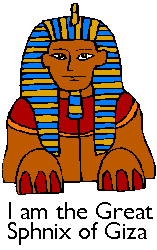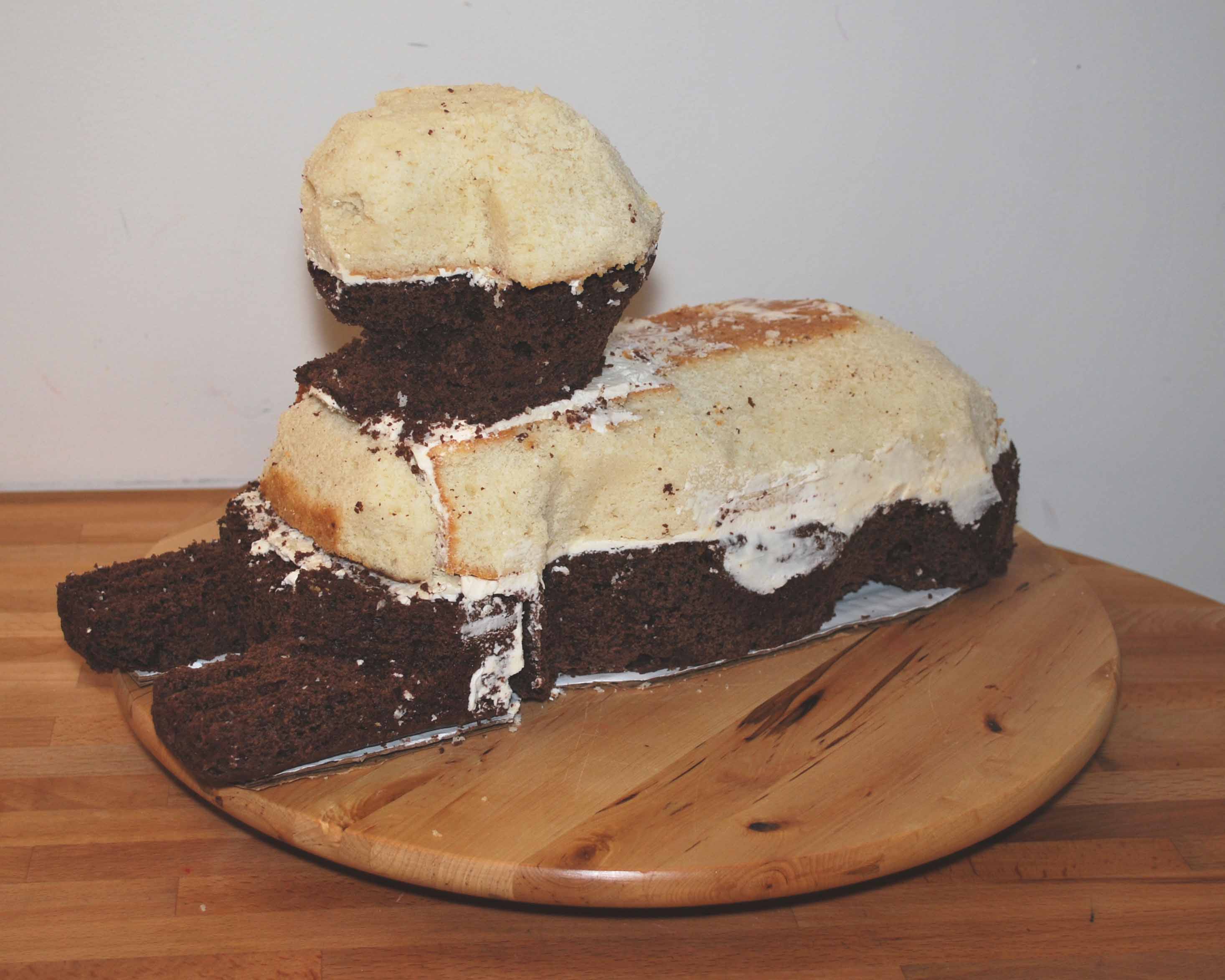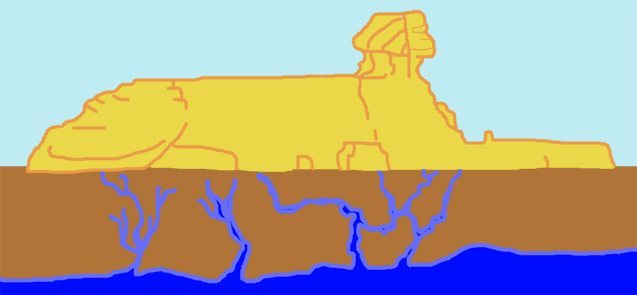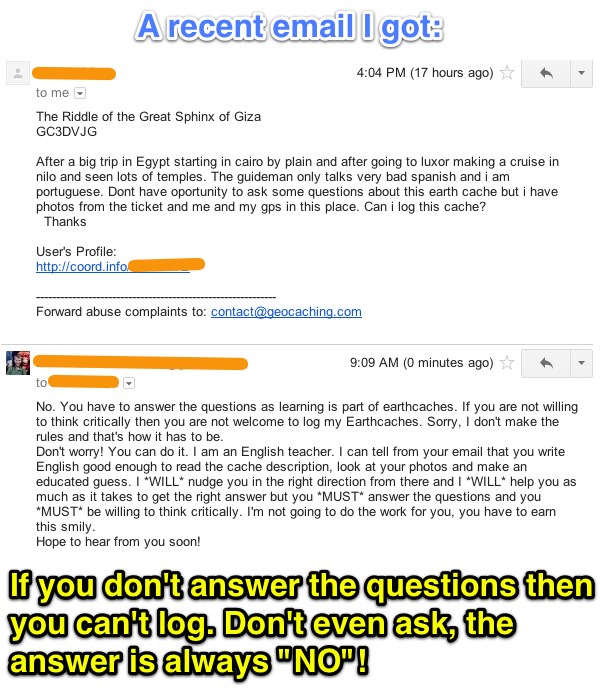A Riddle:
My head is as big as a house.
My body weighs as much as 40 jet airplanes.
I have two long paws as long as a city bus.
I have a long tail wrapped around my back.
My name in Arabic means “The Terrifying One”.
Who or what am I?



The Great Sphinx of Giza (henceforth known in this cache description as simply “The Sphinx”) is a large limestone statue of a reclining sphinx – a mythological creature with a lion’s body and a human head. It is 73.5 meters (241 ft) long, 6 meters (20 ft) wide, and 20.22 m (66.34 ft) tall making it one of the largest carved statues in the world and it dates to the reign of the pharaoh Khafra circa 2558–2532 BCE.
As you approach the Sphinx, with Kufu’s Great Pyramid in the background you will be tempted to assume that the Sphinx and Kufu’s Pyramid were built the same way. Although Kufu’s Pyramid was built by stacking limestone blocks, the Sphinx was not built this way. The Sphinx is a monolith and as such it was carved out of a singe piece of rock. But if stacking blocks did not build the Sphinx, how was it built? For that answer we need to understand the Geology of the Giza plateau.
The Giza plateau was once a prehistoric sea. When these ancient inhabitants died they fell to the bottom in the form of organic matter. As many sea animals including nearly all invertebrates take calcite from the sea water to form their shells and skeletons.

Over time the organic matter composed mainly of calcium carbonate (CaCO3) compressed and formed limestone. Then 50 million years ago, the ancient sea receded leaving a shallow lagoon. Over dozens of millennia the carbonate mud petrified to become the layers from which the pyramid builders quarried limestone blocks and from which the Sphinx was born.
But not all limestone has the same hardness, some is formed as previously described is very hard. However, limestone often forms with impurities such as clay and sand which cause it to be much softer. As you visually examine the Great Sphinx you will notice that some areas seem more eroded than others. This is because limestone consists of hard and soft layers, like a layer cake. Imagine the cake shown to the right is the Sphinx. The white cake represents hard limestone and the brown cake represents soft limestone. The picture of the cake gives you a good visual idea how the limestone that makes up the Sphinx formed. Don't be fooled, the Sphinx cake is very tasty while the real Sphinx is not.Do not try to eat the Great Sphinx.
previously described is very hard. However, limestone often forms with impurities such as clay and sand which cause it to be much softer. As you visually examine the Great Sphinx you will notice that some areas seem more eroded than others. This is because limestone consists of hard and soft layers, like a layer cake. Imagine the cake shown to the right is the Sphinx. The white cake represents hard limestone and the brown cake represents soft limestone. The picture of the cake gives you a good visual idea how the limestone that makes up the Sphinx formed. Don't be fooled, the Sphinx cake is very tasty while the real Sphinx is not.Do not try to eat the Great Sphinx.
Because the entire plateau was once a sea bed, the soil is naturally full of salt. Salt is not a friend to the Great Sphinx; it is constantly and continually damaging it. The damage done to the Sphinx by the salt is two fold in a process called haloclasty: First the water table (which is only 3.6 meters --12 feet below the sphinx) rises up from the water bearing rock below the Sphinx into the naturally porous limestone that makes up the sphinx. This process partially decomposes it.

The second part of the process is caused by the hot Egyptian sun which bakes the Sphinx and draws out the moisture from the limestone through evaporation. This leaves the salt trapped inside the Sphinx to crystallize and expand up to three time its size. This exerts enormous pressure on the rock, breaking it apart. Now the smallest breeze or the slightest rain causes the weakened rock to flake off or wash away. This process then starts anew on the freshly exposed rock in an unending cycle.
Solving the Sphnix's riddle
(Validating this Earthcache Find)
Please answer these questions in your own words:
1. Please describe how the hard and soft layers appear today.
2. Visually examine the erosion patterns on the side of the Sphinx, paying careful attention to the soft and hard limestone that exists. Compare the side of the Sphinx that to the erosion on the side of the sphinx ditch and the quarry wall that encircles the Sphinx. What do you notice? How is it the same or different? What does this tell you about how the Sphinx was built?
3. Compare the Sphinx’s face with that of it’s body. What does this tell you about the rock from which it was carved? What does this explain about the head and the body?
4. Pay careful attention to the sizes of bricks that have been used to repair the Sphinx. What do you notice about them, specifically their age? How many age groups of bricks do you see? Estimate their age. Explain the purpose these brick have? Are they doing what they are intended? Why or why not?
ALL answers should relate to *geology*. Not any other subject. Not history. Not math. No answers relate to aliens or extraterrestrials (yes, I get answers about aliens. every month!). I mean do I really have to say this? Its an EARTH cache give me EARTH science related answers. Please.
أبو الهول في الجيزة، تمثال الحجر الجيري كبير من لأبو الهول مستلق - وهو مخلوق الأسطورية بجسد أسد ورأس إنسان. هو 73،5 مترا، واسع 6 أمتار، وطوله 20.22 متر مما يجعلها واحدة من التماثيل المنحوتة أكبر في العالم. بل هي أيضا قديمة جدا لأنها تعود إلى عهد الفرعون خفرع 2558-2532 قبل الميلاد
مع الاقتراب من أبو الهول، مع هرم خوفو العظيم في الخلفية سوف يميل إلى افتراض أن تم بناء تمثال ابو الهول والهرم خوفو بنفس الأسلوب. على الرغم من أن تم بناء الهرم خوفو عن طريق التراص كتل من الحجر الجيري، لم يتم بناء تمثال ابو الهول على هذا النحو. أبو الهول منليث وعلى هذا النحو كان محفور من قطعة أحرق من الصخر. ولكن إذا لم تبن أبو الهول بقوالب التراص، وكيف تم بناؤها؟ من أجل الإجابة على ذلك نحن بحاجة إلى فهم الجيولوجيا في هضبة الجيزة.
وكانت هضبة الجيزة مرة واحدة في البحر ما قبل التاريخ. عندما توفي هؤلاء السكان القدماء وهبط إلى الأسفل بشكل مواد عضوية. كما العديد من الحيوانات البحرية بما في ذلك جميع اللافقاريات التي شكلت قذائف والهياكل العظمية من الكالسيت في مياه البحر.

مع مرور الوقت, المواد العضوية, والذي يتألف أساسا من كربونات الكالسيوم أصبحت مضغوطة وشكلت الحجر الجيري. ثم قبل خمسون مليون سنة، البحر القديمة انحسر مغادرة بحيرة ضحلة. على مدى عشرات السنين كربونات في الوحل تحجرت لتصبح طبقات. وكان من هذه الطبقات أن بناة الهرم تستخرج كتل الحجر الجيري من أجل بناء أبو الهول
لكن لم يتم إنشاء جميع الحجر الجيري على قدم المساواة. بعض التي يتم تشكيلها على النحو المبين سابقا من الصعب جدا. ومع ذلك، غالبا ما يشكل الحجر الجيري مع الشوائب مثل الطين والرمل الذي يسبب لها أن تكون أكثر ليونة من ذلك بكثير. إذا كنت فحص أبو الهول بصريا ستلاحظ أن تبدو بعض المقاطع المتآكلة أكثر من غيرها. وذلك لأن الحجر الجيري يتكون من طبقات الصلبة و اللينة، مثل كعكة طبقة. تخيل أن كعكة في الصورة هو أبو الهول. الكعكة الأبيض يمثل الحجر الجيري الصلب والكعكة البني يمثل الحجر الجيري اللين. صورة من الكعكة تعطيك فكرة بصرية بشكلا جيدة كيفية الحجر الجيري أبو الهول تشكيلها. لا ينخدع، وكعكة أبو الهول لذيذ جدا في حين أن أبو الهول الحقيقية ليست كذلك. لا تحاول أن تأكل أبو الهول

لأن الهضبة التي يجلس أبو الهول وكان مرة واحدة في قاع البحر، والتربة تحتوي على الكثير من الملح. الملح ليس صديقا لأبو الهول، انه يلحق ضررا له باستمرار. الأضرار التي لحقت أبو الهول من الملح هو نتيجة لعملية من خطوتين. اسم العملية,” هالوكلاستي.” أولا، مستوى المياه الجوفية (والذي هو مجرد 3.6 متر - 12 قدما تحت أبو الهول) ترتفع من الأرض تحت أبو الهول في الحجر الجيري المسامي الطبيعي أن يجعل حتى أبو الهول. هذه العملية تتحلل جزئيا

ويتسبب في الجزء الثاني من هذه العملية عن طريق الشمس المصري الساخنة التي يخبز أبو الهول وتسحب الرطوبة من الحجر الجيري من خلال التبخر. هذا يترك الملح المحاصرين داخل أبو الهول لبلورة وتوسيع حتى يصل إلى حجمه ثلاث مرات. التوسع تمارس ضغطا كبيرا على الصخرة، الامر الذي ادى الى التفكك. الآن أصغر نسيم أو أدنى المطر يتسبب في صخرة ضعيفة إلى تقشر وتآكل. وتبدأ هذه العملية بعد ذلك من جديد على الصخور المكشوفة حديثا في دائرة لا تنتهي.
حل لغز أبو الهول (التحقق من صحة هذه Earthcache البحث) الرجاء الإجابة على هذه الأسئلة بالكلمات الخاصة بك: 1. تصف كيفية الطبقات المادية وغير المادية من أبو الهول يظهر اليوم 2. ادرس أنماط تآكل في جانب أبو الهول، مع إيلاء الاهتمام الدقيق لالجيري الصلبة و اللينة. قارن جانب أبو الهول إلى جانب خندق أبو الهول والجدار المحجر الذي يطوق أبو الهول. ماذا تلاحظ؟ كيف هم نفس أو مختلفة؟ ماذا يعني هذا و يقول لكم عن كيف تم بناء أبو الهول؟ 3. قارن حجر من وجه أبو الهول مع أن جسمه. ماذا يمكن أن تقوله عن صخرة من الذي نحتت عليه؟ ماذا يعني هذا شرح عن الرأس والجسم؟ 4. عطي اهتماما كبيرا لأحجام مختلفة من الطوب التي استخدمت لاصلاح أبو الهول. ماذا تلاحظ عنهم، وتحديدا سنهم؟ كم من الفئات العمرية من الطوب تنظرون؟ تقدير سنهم.. شرح الغرض هذه الطوب. يفعلون ما يقصد منها؟ لماذا أو لماذا لا؟
Le Grand Sphinx de Gizeh (ci-après connu sous le nom de "Sphinx") est une grande statue de calcaire représentant un animal couché - une créature mythologique avec un corps de lion et une tête humaine. Il mesure 73,5 mètres de long, 6 mètres de large et 20,22 mètres de hauteur, ce qui en fait l'une des plus grandes statues sculptées au monde et remonte au règne du pharaon Khafra vers 2558- 2532 BCE. En approchant du Sphinx, avec la Grande Pyramide de Kufu en arrière-plan, vous serez tenté de supposer que le Sphinx et la Pyramide de Kufu ont été construits de la même manière. Bien que Pyramide Kufu ait été construite en empilant des blocs de calcaire, le Sphinx n'a pas été construit de cette façon. Le Sphinx est un monolithe et en tant que tel, il a été taillé dans un morceau de roche unique. Si le Sphinx n’a pas été construit pas un empilage de blocs , comment a-t-il été construit? Pour cette réponse, nous devons comprendre la géologie du plateau de Gizeh. Le plateau de Gizeh était jadis une mer préhistorique. Quand ces anciens habitants sont morts, ils sont tombés au fond sous forme de matière organique. Comme de nombreux animaux marins, y compris presque tous les invertébrés, c’est la calcite de l'eau de mer qui a formé leurs coquilles et squelettes. Au fil du temps, la matière organique composée principalement de carbonate de calcium (CaCO3) a été comprimée et a formé le calcaire. Il y a environ 50 millions d'années, l'ancienne mer a reculé laissant un lagon peu profond. Quelques douzaines de millénaires plus tard, la boue de carbonate pétrifiée formait des couches solides. C’est à partir de ces couches que les constructeurs de pyramide extrayaient des blocs de calcaire à partir desquels le Sphinx est né. Mais pas tous les calcaires n’ont la même dureté. Certains sont très résistants. Mais le calcaire se forme souvent avec des impuretés telles que l'argile et le sable qui vont le rendre beaucoup plus doux. En examinant visuellement le Grand Sphinx, vous remarquerez que certaines zones semblent plus érodées que d'autres. C'est parce que le calcaire se compose de couches dures et douces, comme un mille-feuilles. Imaginez que le Sphinx est un mille-feuilles. Les parties blanches représentent le calcaire dur et les parties brunes représentent le calcaire doux. L'image du gâteau vous donne une bonne idée visuelle de la structure du Sphinx. Parce que le plateau entier était autrefois un fonds marin, le sol est naturellement plein de sel. Le sel n'est pas un ami du Grand Sphinx; Elle l'endommage constamment et continuellement. Les dégâts causés au Sphinx par le sel sont de deux ordres. Le processus est appelé haloclastique: D'abord la nappe phréatique (qui est seulement à 3,6 mètres au-dessous du sphinx) monte de la roche sous le Sphinx, et pénètre le Calcaire qui constitue le sphinx. Ce processus le décompose partiellement. La deuxième partie du processus est causée par le soleil chaud égyptien qui chauffe le Sphinx et provoque l’évaporation de l'humidité du calcaire. Cela laisse le sel piégé à l'intérieur du Sphinx. Celui-ci cristallise et son volume peut tripler. Cela exerce une énorme pression sur le rocher, le brisant. Maintenant, la plus petite brise ou la moindre pluie fait que la roche affaiblie s'échappe ou se lave. Ce processus commence alors de nouveau sur la roche fraîchement exposée dans un cycle sans fin.
Résoudre l'énigme du Sphinx (Validation de cette recherche Earthcache) Répondez à ces questions : 1. Veuillez décrire comment les couches dures et douces apparaissent aujourd'hui. 2. Examiner visuellement les motifs d'érosion sur le côté du Sphinx, en accordant une attention particulière au calcaire doux et dur qui existe. Comparez le côté du Sphinx à l'érosion sur le côté du fossé du sphinx et le mur de carrière qui entoure le Sphinx. Que remarquez-vous? Est-il le même ou est-il différent? Qu'est-ce que cela vous indique sur la façon dont le Sphinx a été construit? 3. Comparez le visage du Sphinx à celui de son corps. Qu'est-ce que cela vous dit sur la roche à partir de laquelle il a été sculpté? Qu'est-ce que cela explique sur la tête et le corps? 4. Faites attention aux tailles de briques qui ont été utilisées pour réparer le Sphinx. Que remarquez-vous à leur sujet, en particulier leur âge? Combien de tranches d'âge de briques voyez-vous? Estimez leur âge. Expliquer le but de ces briques? Est-ce qu'ils font ce qu'ils veulent? Pourquoi ou pourquoi pas?
--------------------------------------------------------------------- Et voici mes réponses pour valider mon passage : 1. Les couches dures sont restées lisses, peu abimées. Les couches impures sont rongées, abimées.
2. On retrouve le même phénomène au niveau du mur de carrière : des zones creusées alternent avec des zones visiblement plus dures. Cela laisse supposé que le sphinx a été sculpté en creusant la roche.
3. La tête est parfaitement conservée, contrairement à la zone du cou. Il semble que ce soit la raison pour laquelle la « barbe » du Sphinx a disparue, car taillée dans une zone trop fragile. Le nez serait sans doute encore là, si l’armée ne s’était entraînée au canon dessus.
Transportation
 Metro: Metro Line 2 now runs from Cairo into Giza, although it does not go all the way to the Pyramids. Get off at Giza station (not the terminus!). The pyramids are 8 km, 15-20 min trip due southwest on the long Al-Haram avenue that the train crosses over just before stopping at the station. That is effectively a “right turn” from the line you have just been taking. Any number of minibuses and buses go to the site (known as “al-haram” in Arabic) they include the green public 900 and 997 buses.
Metro: Metro Line 2 now runs from Cairo into Giza, although it does not go all the way to the Pyramids. Get off at Giza station (not the terminus!). The pyramids are 8 km, 15-20 min trip due southwest on the long Al-Haram avenue that the train crosses over just before stopping at the station. That is effectively a “right turn” from the line you have just been taking. Any number of minibuses and buses go to the site (known as “al-haram” in Arabic) they include the green public 900 and 997 buses.
 Taxi: It is possible to take a taxi to the Pyramids from any part of Cairo. Make sure you only use the Solid-yellow and solid-white taxis - These are metered and air conditioned. The older black taxis are NOT metered and often do not have seat belts and other basic safety gear like headlights. They simply are not safe. Take only a yellow or yellow and white taxi. Once you flag a taxi down simply ask to go to the Pyramids.
Taxi: It is possible to take a taxi to the Pyramids from any part of Cairo. Make sure you only use the Solid-yellow and solid-white taxis - These are metered and air conditioned. The older black taxis are NOT metered and often do not have seat belts and other basic safety gear like headlights. They simply are not safe. Take only a yellow or yellow and white taxi. Once you flag a taxi down simply ask to go to the Pyramids.
 Bus: A Bus From central Cairo, the optimum way to get to the Giza Pyramids using public mass transit options is by bus routes 355 or 357 - a large white, air-conditioned coach with CTA (Cairo Transport Authority) on the side. Travelling every 20 minutes from the airport and Heliopolis, the bus stops (or doesn't - you may have to flag it down!) at the Abdel Menem Riyad Station in Midan Tahrir, next to the Egyptian Museum, before continuing out to Giza and the Pyramids. Tickets costs 2 Egyptian pounds - a bargain!
Bus: A Bus From central Cairo, the optimum way to get to the Giza Pyramids using public mass transit options is by bus routes 355 or 357 - a large white, air-conditioned coach with CTA (Cairo Transport Authority) on the side. Travelling every 20 minutes from the airport and Heliopolis, the bus stops (or doesn't - you may have to flag it down!) at the Abdel Menem Riyad Station in Midan Tahrir, next to the Egyptian Museum, before continuing out to Giza and the Pyramids. Tickets costs 2 Egyptian pounds - a bargain!
Even cheaper and more interesting is taking the ordinary buses 900 or 997, costing 50 piastres, from the big central bus station under the overpasses, close to the museum. There are three lanes, and they leave from one closest to the rundown controllers' booth. Be careful when about getting down, most people will be honest and help you, but you may encounter scammers who take you to their camels instead of to the pyramids. For 997, the correct spot is along a long avenue, after you have spotted the Pyramids and the bus has done a U-turn and then turned left — get off when you a see a blue sign for the Light and Sound show


